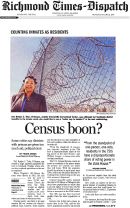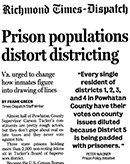Fixing prison-based gerrymandering after the 2010 Census: Virginia
50 State Guide, March 2010
- Sections
- Impact at the state level
- Impact at the local level
- Virginia law says a prison cell is not a residence
- Other solutions
- Additional resources
Prison-based gerrymandering violates the constitutional principle of “One Person, One Vote.” The Supreme Court requires districts to be based on equal population in order to give each resident the same access to government. But a longstanding flaw in the Census counts incarcerated people as residents of the prison location, even though they can’t vote and aren’t a part of the surrounding community.
When legislators claim people incarcerated in their districts are legitimate constituents, they award people who live close to the prison more of a say in government than everybody else.
Impact at the state level:
- After the 2000 Census, the state’s 100 House of Delegates districts were required to contain 70,785 residents, plus or minus 2% (1,416 people). Fourteen House of Delegates districts included more than 1,416 incarcerated people as population. In 7 districts, the actual populations of the district (without claiming incarcerated people as residents) left the districts more than 4% under the ideal population.
- The more than 9,000 prisoners credited to the 75th district after the 2000 Census enhanced the weight of a vote cast in that district by almost 15%; giving every group of 85 people in the district as much influence in the capital as 100 people in any other district.
The 75th District is represented by Del. Rosyln C. Tyler, who in 2007 told the Times-Dispatch that she’d like to see things changed:
Though Tyler’s district benefits, she would like to see things changed when redistricting is performed in 2011 based on the 2010 census.
“I believe that there should be a better way to handle it,” said Tyler, perhaps by counting inmates where they came from and not where they are held.
Impact at the local level:
- Virginia law encourages counties to exclude prison populations in redistricting when such population exceeds 12 percent of the total county population. Va. Code Ann. S 24.2-304.1 (C).
- Of the five counties eligible under the law after the 2000 Census, four (Brunswick, Greensville, Richmond and Sussex) excluded the prison population.
- Powhatan County's 5th Board of Supervisors District, drawn after the 2000 Census, was 41% incarcerated. The district color-coded the "White Area" on the Southampton County Board was 58% incarcerated. In Nottoway County, the large prisons were about a quarter of the population in the First and Third Supervisory Districts. A vote cast in any of these districts was worth substantially more -- and in the case of Southampton County -- more than twice as much as votes cast in other districts that have the required number of actual residents.
- More research needs to be done in Lunenburg County which may have a county supervisory district that is more than 40% prisoners, giving the residents who live next to the prison almost twice the influence over residents in other county districts. See the Democracy Toolkit for a suggested research methodology, or contact us if you have a copy of the county's Supervisory maps.
- More research needs to be done in Culpeper County which may have a county supervisory district that is 26% prisoners, giving every 74 residents who live next to the prison as much influence as 100 residents in other county districts. See the Democracy Toolkit for a suggested research methodology, or contact us if you have a copy of the county's Supervisory maps.
- Wise County had large prisons relative to its population in 2000, but the Census erred and placed the prisons outside of the county. The error was corrected, but too late for redistricting. The decision on whether to include the prison populations when drawing county supervisory districts will be important when the Census Bureau counts the prisons in the county in 2010.
- Unless corrective action is taken, the new federal prison in Lee County could be about a third of a district, and the expanded federal prison in Prince George County could, combined with the regional jail at the same location, be a large part of a county district, giving the residents of the district with the prison more influence than residents elsewhere. Tazewell County's new Pocahontas State Correctional Center will create a district where about 11% of the population is incarcerated. The problem is already receiving debate in Pittsylvania County.
- Other counties with large prisons that will be forced to engage in prison-based gerrymandering include: Augusta, Bland, Fluvanna, Goochland, Mecklenburg, and Russell counties.
Virginia law says a prison cell is not a residence:
- Incarceration is not voluntary, so a prison cell cannot be a residence under Virginia law: “as used in the Virginia election laws, ‘residence’ is substantially synonymous with ‘domicile’… A change of place without the intent to abandon the old and acquire a new domicile will not work a change of legal residence.” Kegley v. Johnson, 147 S.E.2d 735, 736, 207 Va. 54, 56 (1966) citing Bruner v. Bunting, 15 Va. Law Reg. 514, 516-518 (1909).
Other solutions:
- Ideally, the U.S. Census Bureau would change where it counts incarcerated people. They should be counted as residents of their home — not prison — addresses. There is no time for that in 2010, but Virginia should ask the Census Bureau for this change for 2020.
- After the 2010 Census, the state and its local governments should, to the degree possible, count incarcerated people as residents of their home communities for redistricting purposes. Where that is not feasible, incarcerated people should be treated as providing unknown addresses instead of being used to pad the legislative districts that contain prisons.
Additional resources:
- Virginia campaign page is an actively maintained list of links to facts sheet, news articles, endorsements and other resources on prison-based gerrymandering in Virginia.
 Census boon?, an article by Frank Green of the Times-Dispatch, on the effects of counting incarcerated people at the prison’s address in Virginia, January 22, 2007
Census boon?, an article by Frank Green of the Times-Dispatch, on the effects of counting incarcerated people at the prison’s address in Virginia, January 22, 2007-
 Legislature urged to change prisoners' role in districting, by Frank Green, Richmond Times-Dispatch (Virginia), September 5, 2010.
Legislature urged to change prisoners' role in districting, by Frank Green, Richmond Times-Dispatch (Virginia), September 5, 2010. - Incarcerated People and the Census: Painting a Distorted Picture of Virginia [PDF], a report issued by the Brennan Center for Justice, this report outlines the state level effects of the United States Census Bureau’s policy for counting prison populations.
- A list of new large prisons built in Virginia since the 2000 Census. These prisons are likely to create new prison-based gerrymandering problems after their populations are counted in the 2010 Census.
Events
- April 30, 2025:
On Wednesday, April 30th, at noon Eastern, Communications Strategist Wanda Bertram will take part in a panel discussion with The Center for Just Journalism on the 100th day of the second Trump administration. They’ll discuss the impacts the administration has had on criminal legal policy and issues that have flown under the radar. Register here.
Not near you?
Invite us to your city, college or organization.
 Census boon?
Census boon? Legislature urged to change prisoners' role in districting
Legislature urged to change prisoners' role in districting


